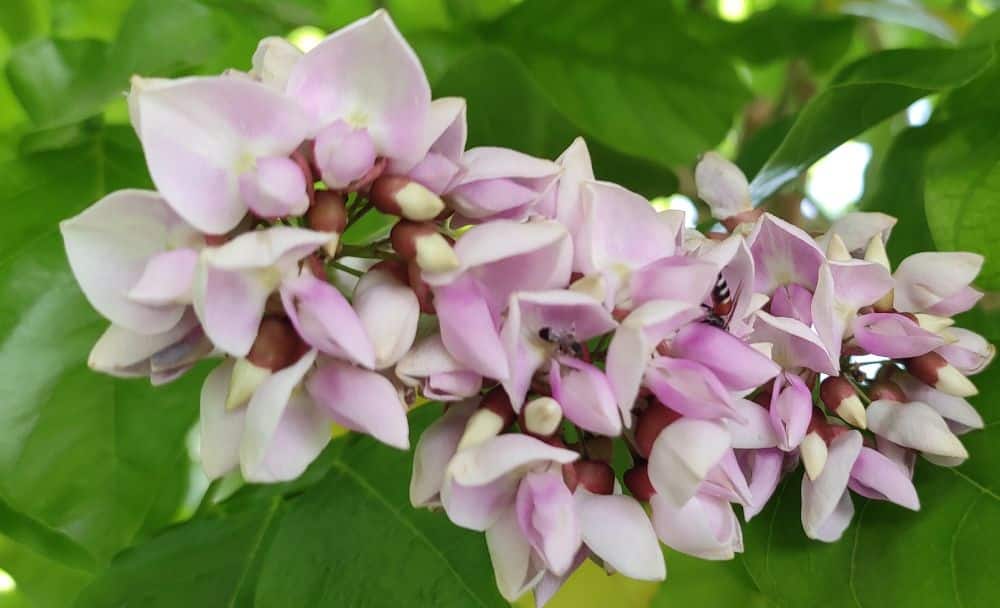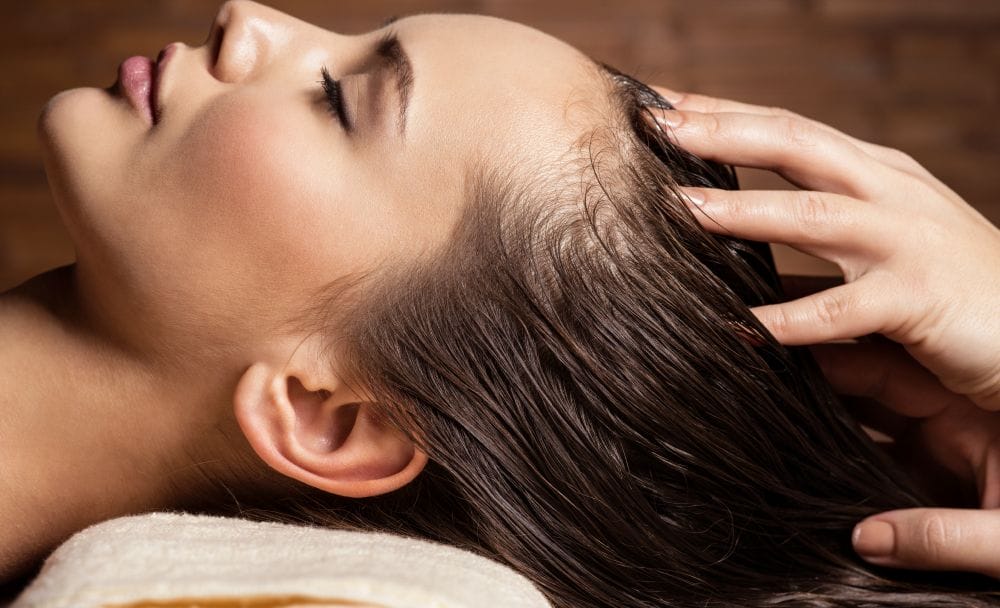Karanja, scientifically known as Pongamia pinnata(Millettia pinnata), is a tropical tree native to parts of Asia and Africa. [1] [2] It has been used for centuries in traditional medicine due to its numerous health benefits. Karanja oil, derived from the seeds of the tree, is known for its medicinal properties and is commonly used in Ayurvedic and alternative medicine practices. In this article, we will explore the health benefits, uses, dosage, and potential side effects of Karanja.

What is Karanja?
Karanja is a medium-sized evergreen tree that belongs to the legume family. It can reach a height of up to 15 metres and has compound leaves with numerous leaflets. The tree produces clusters of fragrant, white, pink, or purple flowers, which eventually develop into long, flat seed pods containing the valuable Karanja seeds. These seeds are rich in bioactive compounds that contribute to the tree’s medicinal properties. [1] [2]
Benefits and Uses of Karanja
1. Anti-inflammatory properties
Karanja oil contains flavonoids and other compounds that possess potent anti-inflammatory effects. These properties make it beneficial for relieving pain and inflammation associated with conditions like arthritis, rheumatism, and gout. [3] [4]
2. Antimicrobial activity
Karanja oil exhibits broad-spectrum antimicrobial activity against various bacteria, fungi, and parasites. It can be used topically to treat skin infections, such as acne, eczema, and dermatitis. Additionally, it may help combat certain fungal infections and parasites when applied or used as a supplement. [5] [6]
3. Wound healing

The application of Karanja oil on wounds and cuts may accelerate the healing process. It possesses wound-healing properties and can aid in tissue repair, reducing the risk of infections and promoting faster recovery. [7] [8]
4. Skincare

Karanja oil is commonly used in skincare products due to its moisturising and nourishing properties. It can help soothe dry and irritated skin, reduce the appearance of scars and blemishes, and improve overall skin health. [9]
5. Hair care

Karanja oil is also used in hair care products due to its nourishing and conditioning properties. It can help moisturise the scalp, reduce dandruff, and improve hair texture and shine. [10] [11]
Dosage and Precautions
When using Karanja oil topically, it is recommended to dilute it with a carrier oil, such as coconut or olive oil, to avoid skin irritation. A typical ratio is 1 part Karanja oil to 3 parts carrier oil.
As for oral consumption or supplementation of Karanja oil, it is important to consult with a healthcare professional or an Ayurvedic practitioner to determine the appropriate dosage for your specific needs. The dosage can vary depending on factors such as age, overall health, and the condition being targeted.
It is worth noting that Karanja oil should not be consumed internally by pregnant women, as it may have potentially toxic effects on the developing foetus. Additionally, individuals with known allergies or hypersensitivity to legumes should exercise caution when using Karanja oil topically or orally, as it may trigger an allergic reaction.
Potential Side Effects
While Karanja oil is generally considered safe for topical use, some individuals may experience skin irritation or allergic reactions. It is advisable to perform a patch test on a small area of skin before applying the oil more extensively.
When used orally, Karanja oil may cause digestive discomforts, such as nausea, stomach cramps, or diarrhoea, in some individuals. It is important to start with a low dosage and gradually increase it if tolerated well.
In rare cases, Karanja oil may interact with certain medications or supplements. If you are taking any prescription medications or have underlying health conditions, it is essential to consult with a healthcare professional before using Karanja oil internally.
FAQs about Karanja
1. Can Karanja oil be used in combination with other oils or ingredients?
Yes, Karanja oil can be combined with other carrier oils, such as coconut oil, olive oil, or almond oil, for easier application and enhanced benefits. Mixing Karanja oil with other essential oils, such as lavender or tea tree oil, can also create synergistic effects and provide additional therapeutic benefits. However, it is important to research and understand the properties and potential interactions of each oil or ingredient before combining them. Some oils may have specific contraindications or sensitivities that need to be considered.
2. How should Karanja oil be stored?
Karanja oil should be stored in a cool, dark place away from direct sunlight and heat. Exposure to light and heat can degrade the quality and effectiveness of the oil. It is best to store it in a tightly sealed, amber-colored glass bottle to protect it from air and light. When stored properly, Karanja oil can have a relatively long shelf life.
3. Can Karanja oil be used on all skin types?
Karanja oil is generally suitable for all skin types. However, individuals with sensitive skin or specific skin conditions may need to exercise caution. It is recommended to perform a patch test and observe the skin’s reaction before applying it more extensively. If any irritation or discomfort occurs, discontinue use and consult a healthcare professional.
4. Can Karanja oil be used for pets?
While Karanja oil has been used in some natural pet care products, it is important to consult with a veterinarian before using it on pets. Animals may have different sensitivities and reactions to essential oils, so it is crucial to ensure the safety and appropriateness of using Karanja oil on your pets.
5. Does Karanja oil have any interactions with medications?
Karanja oil may interact with certain medications. It is advisable to consult with a healthcare professional or pharmacist if you are taking any prescription medications or have underlying health conditions. They can provide guidance on potential interactions and ensure the safe use of Karanja oil alongside your medications.
Conclusion
Karanja, a tropical tree with potent oil derived from the seeds, offers a range of health benefits and applications. From its anti-inflammatory and antimicrobial properties to wound healing and skincare benefits, Karanja has been utilised in traditional medicine for various purposes.
However, it is crucial to approach the use of Karanja oil with caution. Dosage recommendations and precautions should be followed, especially when considering internal consumption. As with any natural remedy, it is always advisable to consult with a healthcare professional or an Ayurvedic practitioner before incorporating Karanja oil into your health routine, particularly if you are pregnant, have allergies, or are taking other medications.
By understanding the potential benefits, uses, dosage, and side effects of Karanja, individuals can make informed decisions and harness its properties effectively and safely.
Disclaimer: This Article is for informative purposes only and does not constitute medical advice. Kindly contact a medical professional before attempting any treatments mentioned in the article yourself.
References:
- Millettia pinnata (L.) Panigrahi GRIN-Global (ars-grin.gov)
- Pongamia pinnata var. pinnata (lucidcentral.org)
- Synthesis, characterization and anti-inflammatory properties of karanjin (Pongamia pinnata seed) and its derivatives – ScienceDirect
- A feasible method for isolation of pongamol from karanja (Pongamia pinnata) seed and its anti-inflammatory activity – ScienceDirect













